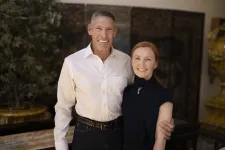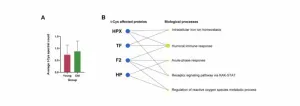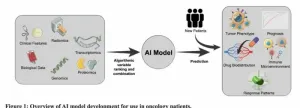(Press-News.org) LOS ANGELES — Over 6.5 million Americans experience chronic wounds — wounds that do not heal after a few months. Almost all such wounds contain bacteria, which, if not detected and removed, can lead to severe infection and resulting complications, including amputation if a limb is involved.
This is especially true for patients with diabetic foot ulcers (open sores), which affects one-third of people with diabetes. Approximately 20% of those who develop a diabetic foot ulcer will require a lower-extremity amputation, according to the American Diabetes Association.
When physicians debride, or clean out, a wound, they remove as much bacteria as possible. However, they face one key limitation — not all bacteria can be seen by the human eye, and some may be missed during the debridement.
New Keck Medicine of USC research published in Advances in Wound Care suggests there may be a more effective method to detect bacteria during wound debridement. Autofluorescence (AF) imaging, where a handheld device “lights up” bacteria previously invisible to the human eye, uses violet light to illuminate molecules in the cell walls of any bacteria. Different types of bacteria turn different colors, allowing physicians to immediately determine how much and which types of bacteria are in the wound.
“We’re hopeful this new technology can help surgeons improve their accuracy when pinpointing and consequently removing bacteria from wounds and therefore improve patient outcomes, particularly for those with diabetic foot wounds,” said David G. Armstrong, DPM, PhD, a podiatric surgeon and limb preservation specialist with Keck Medicine and senior author of the study. “The early detection and removal of bacteria from a wound is vital to preventing avoidable amputations.”
The research, a literature review of 25 studies examining the effectiveness of AF imaging in treating diabetic patients with foot ulcers, reveals that AF imaging can identify bacteria in wounds in approximately 9 in 10 patients that traditional clinical assessments miss.
Traditionally, physicians debride wounds, then send tissue samples to the lab to identify specific types of bacteria present in the wound and determine the best treatment protocol based on those findings, such as starting the patient on antibiotics or providing a special type of wound dressing. This process can take days, during which time an infection can set in, said Armstrong.
With AF imaging physicians are able to make medical decisions during the wound debridement, rather than waiting for lab results to initiate treatment.
Another benefit to the technology is that if bacteria is caught early, the patient may avoid being prescribed antibiotics, which in wound care can be prolonged, thus avoiding possible antibiotic resistance.
“This real-time intervention may allow for faster, more effective treatment for wounds,” said Armstrong.
Keck Medicine physicians are already using the technology to successfully treat patients with chronic wounds, including diabetic foot ulcers.
“I look forward to more research in this area as we hope to see AF imaging become the standard of care for wound care in the near future,” said Armstrong.
The study is partially supported by the National Institutes of Health, National Institute of Diabetes and Digestive and Kidney Diseases, Award Number 1R01124789-01A1 and the National Science Foundation (NSF) Center to Stream Healthcare in Place (#C2SHiP) CNS Award Number 2052578.
###
For more information about Keck Medicine of USC, please visit news.KeckMedicine.org.
END
New technology ‘lights up’ bacteria in wounds for better infection prevention
Innovative tool could potentially reduce chronic wound complications and improve patient outcomes
2024-08-27
ELSE PRESS RELEASES FROM THIS DATE:
UCLA receives $120 million from Alya and Gary Michelson for new California Institute for Immunology and Immunotherapy
2024-08-27
UCLA has received a $120 million commitment from surgeon, inventor and philanthropist Dr. Gary Michelson and his wife, Alya, to kick-start the California Institute for Immunology and Immunotherapy, an innovative public-private partnership aimed at spurring breakthrough discoveries that prevent and cure diseases and catalyze economic growth and innovation in Los Angeles.
Michelson, a spine surgeon and prolific inventor who holds nearly 1,000 individual patents, is co-founder and chair of the board of the institute, which will be housed at UCLA’s state-of-the-art research park.
The gift, distributed via ...
Dunick receives funding for Center For Economic Education
2024-08-27
Dunick Receives Funding For Center For Economic Education
Jason Dunick, Associate Chair and Term Associate Professor, Economics, College of Humanities and Social Sciences (CHSS), received $108,692 from Virginia Council on Economic Education for: “Center for Economic Education.”
Dunick will use this funding to support the continuation of the services of the Center for Economic Education. The Center supports K-12 teachers who are teaching economics and personal finance in Virginia.
This grant represents the renewal of a long-standing relationship with the ...
National Institutes of Health awards $2.4 million grant to cross-disciplinary team of researchers to study psychedelics for methamphetamine addiction
2024-08-27
FOR IMMEDIATE RELEASE
Media Contacts:
Colleen McDonald
Sr. Consultant, Earned Media
Kara Reed
Director of Development
Lisa Babin
Executive Director of Communications
Medical College of Wisconsin
University of California San Diego
LSU Health Shreveport
414.801.3146 | cmcdonald@mcw.edu
217.390.6629 | k3hendrickson@ucsd.edu
318.675.8769 | lisa.babin@lsuhs.edu
Milwaukee, Wis., August 27, 2024 – John McCorvy, PhD, Assistant Professor in the Department ...
Trioxidized cysteine and aging: Beyond proteinopathic paradigms
2024-08-27
“The results indicated a significant increase in cumulative t-Cys levels and the total number of t-Cys residues in aging and aged mice proteomes compared to young groups.”
BUFFALO, NY- August 27, 2024 – A new research perspective was published in Aging (listed by MEDLINE/PubMed as "Aging (Albany NY)" and "Aging-US" by Web of Science), Volume 16, Issue 15 on July 25, 2024, entitled, “Trioxidized cysteine and aging: a molecular binomial that extends far beyond classical proteinopathic paradigms.”
Oxidative stress (OS) - characterized by an imbalance between oxidants and antioxidants - leads to the formation ...
Artificial intelligence: Revolutionizing precision oncology
2024-08-27
“Properly leveraged AI-based techniques could herald a new era of precision medicine guided by non-invasive, imaging-based disease evaluation."
BUFFALO, NY- August 27, 2024 – A new editorial was published in Oncotarget's Volume 15 on August 26, 2024, entitled, “Artificial intelligence: A transformative tool in precision oncology.”
Artificial intelligence (AI) is revolutionizing society and healthcare, opening new possibilities for precision medicine. In oncology, immunotherapy (IO) has similarly transformed cancer treatment with novel ...
How much microplastic are you drinking? New UBC tool can tell you in minutes
2024-08-27
Micro- and nanoplastics are in our food, water and the air we breathe. They are showing up in our bodies, from testicles to brain matter.
Now, University of British Columbia researchers have developed a low-cost, portable tool to accurately measure plastic released from everyday sources like disposable cups and water bottles.
The device, paired with an app, uses fluorescent labeling to detect plastic particles ranging from 50 nanometres to 10 microns in size – too small to be detected by the naked eye – and delivers results in minutes.
The method and findings are detailed in ACS Sensors.
“The breakdown of larger plastic pieces into microplastics ...
Race and ethnicity and diagnostic testing for common conditions in the acute care setting
2024-08-27
About The Study: White patients discharged from the emergency department with a nonspecific diagnosis of interest were significantly more likely than Black patients to receive related diagnostic testing in this study. The extent to which this represents diagnostic test overuse in white patients vs undertesting and missed diagnoses in Black patients deserves further study.
Corresponding Author: To contact the corresponding author, Michael I. Ellenbogen, M.D., email mellenb6@jhmi.edu.
To access the embargoed study: Visit our For The Media website at this link https://media.jamanetwork.com/
(doi:10.1001/jamanetworkopen.2024.30306)
Editor’s ...
Groundbreaking studies provide key insights into chloroplasts protein import motor
2024-08-27
Two groundbreaking studies published in the journal Cell shed light on the assembly, function and evolutionary diversity of the chloroplast protein import system.
Chloroplasts are fundamental organelles in plant cells that act as the primary site of photosynthesis to sustain life on Earth. Although chloroplasts have their own genome, most of their proteins are encoded in the nucleus and synthesized as preproteins in the cytosol. These preproteins are subsequently transported across the outer and inner envelope membranes of the chloroplasts. The translocon machineries, known as the TOC (translocon at the outer chloroplast membrane) and TIC (translocon at ...
What enables herpes simplex virus to become impervious to drugs?
2024-08-27
All organisms — from fungi to mammals — have the capacity to evolve and adapt to their environments. But viruses are master shapeshifters with an ability to mutate greater than any other organism. As a result, they can evade treatments or acquire resistance to once-effective antiviral medications.
Working with herpes simplex virus (HSV), a new study led by Harvard Medical School researchers sheds light on one of the ways in which the virus becomes resistant to treatment, a problem that could be particularly ...
Keeping native bees buzzing requires rethinking pest control
2024-08-27
Whether you’re strolling through a garden, wandering a park, or simply enjoying an open space in the United States, you’re likely to notice bees buzzing about the flowers. While honeybees, imported from Europe in the 17th century to produce honey, are the most recognizable, they aren’t the only bees at work. If you’re a keen observer, you might spot some of the thousands of less familiar, native bee species that call these spaces home.
Native wild bees play a crucial ecological role, ensuring the survival and reproduction of ...
LAST 30 PRESS RELEASES:
Scientists trace microplastics in fertilizer from fields to the beach
The Lancet Obstetrics, Gynecology, & Women’s Health: Taking paracetamol during pregnancy does not increase risk of autism, ADHD or intellectual disabilities, confirms new gold-standard evidence review
Taking paracetamol during pregnancy does not increase risk of autism, ADHD or intellectual disabilities
Harm reduction vending machines in New York State expand access to overdose treatment and drug test strips, UB studies confirm
University of Phoenix releases white paper on Credit for Prior Learning as a catalyst for internal mobility and retention
Canada losing track of salmon health as climate and industrial threats mount
Molecular sieve-confined Pt-FeOx catalysts achieve highly efficient reversible hydrogen cycle of methylcyclohexane-toluene
Investment in farm productivity tools key to reducing greenhouse gas
New review highlights electrochemical pathways to recover uranium from wastewater and seawater
Hidden pollutants in shale gas development raise environmental concerns, new review finds
Discarded cigarette butts transformed into high performance energy storage materials
Researchers highlight role of alternative RNA splicing in schizophrenia
NTU Singapore scientists find new way to disarm antibiotic-resistant bacteria and restore healing in chronic wounds
Research suggests nationwide racial bias in media reporting on gun violence
Revealing the cell’s nanocourier at work
Health impacts of nursing home staffing
Public views about opioid overdose and people with opioid use disorder
Age-related changes in sperm DNA may play a role in autism risk
Ambitious model fails to explain near-death experiences, experts say
Multifaceted effects of inward foreign direct investment on new venture creation
Exploring mutations that spontaneously switch on a key brain cell receptor
Two-step genome editing enables the creation of full-length humanized mouse models
Pusan National University researchers develop light-activated tissue adhesive patch for rapid, watertight neurosurgical sealing
Study finds so-called super agers tend to have at least two key genetic advantages
Brain stimulation device cleared for ADHD in the US is overall safe but ineffective
Scientists discover natural ‘brake’ that could stop harmful inflammation
Tougher solid electrolyte advances long-sought lithium metal batteries
Experts provide policy roadmap to reduce dementia risk
New 3D imaging system could address limitations of MRI, CT and ultrasound
First-in-human drug trial lowers high blood fats
[Press-News.org] New technology ‘lights up’ bacteria in wounds for better infection preventionInnovative tool could potentially reduce chronic wound complications and improve patient outcomes







